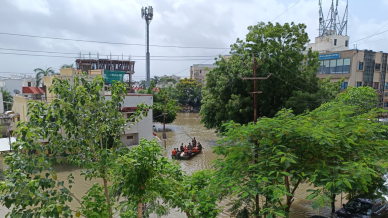Stay updated with the latest - Click here to follow us on Instagram
Cyclone Asna, first since 1964 to form in Arabian sea, to miss Gujarat: IMD
The weather system has already caused extreme weather in Gujarat, even in its pre-cyclonic stage.

The deep depression off the Gujarat coast has intensified into Cyclone Asna — only the second of its kind to form over the Arabian Sea since 1964 — the India Meteorological Department (IMD) said Friday.
Cyclone Asna, named by Pakistan, is moving away from the Indian coast and will not hit Gujarat, as per satellite observations as of 11.30 am Friday. The weather system has already caused extreme weather in the state, even in its pre-cyclonic stage. Additionally, an off-shore trough running from north Kerala to Gujarat will keep the southwest monsoon active to vigorous over the west coast.
monthly limit of free stories.
with an Express account.
In its latest forecast, the IMD said heavy rainfall (64-115 mm in 24 hours) will continue over Gujarat till Saturday. After a brief lull, heavy rainfall is expected over the Kutch-Saurashtra region on September 2 and 3.
“The cyclone will move nearly northwestwards away from the Indian coast along the northern Arabian Sea for the next two days,” the department said Friday.
Cyclones in India, intensifying in the Bay of Bengal or the Arabian Sea, are more common during the pre-monsoon March-May and the post-monsoon October-December periods. The strongest of these storms have developed during May and November. Due to strong monsoon currents and other unfavourable ocean factors, systems rarely intensify into cyclones during the June-September monsoon season — making Cyclone Asna a rare development.
While this is the first cyclone to form in the Arabian Sea since 1964, one such storm had formed over the Indian landmass in 1976 before moving over the Arabian Sea, according to IMD records.
On Friday, Gujarat’s Rajkot, Devbhoomi Dwarka, Jamnagar, Vadodara, Kutch and Saurashtra regions received very heavy to extremely heavy rainfall.
Some of the affected areas were Mandvi (300 mm), Mundra (220 mm), Okha (171 mm), Abdasa (160 mm), Naliya (156 mm), Dwarka (80 mm), Bhuj (57 mm) and Kandla (41 mm).
Over the past week, the rainfall received by Gujarat jumped from 638.3 mm to 927 mm due to the deep depression. The rainfall in the Saurashtra-Kutch region went from 477.4 mm to 799.
As of Friday morning, the cyclone lay at about 190 km west-northwest of Bhuj and 170 km southeast of Karachi, Pakistan.